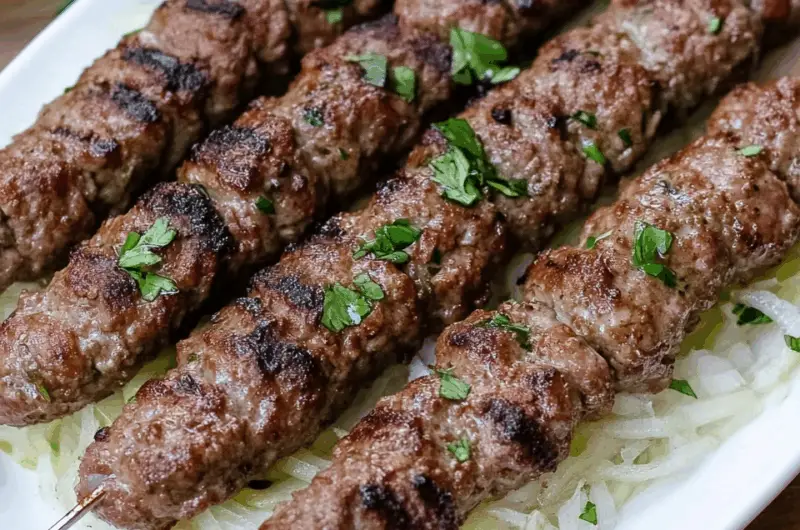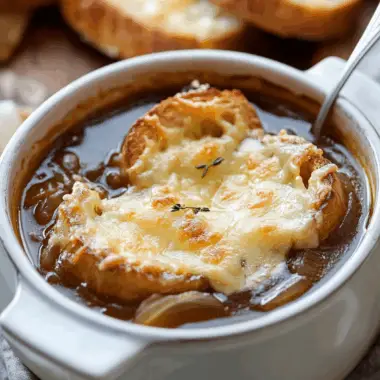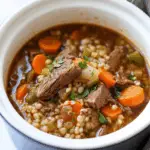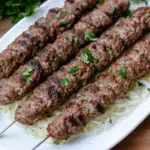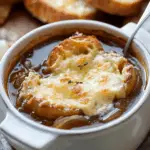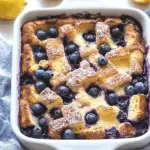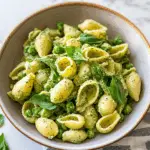The Kafta Skewers recipe is a celebration of Lebanese culinary tradition—rich with the earthy warmth of allspice, the brightness of fresh parsley, and a subtle kick of cayenne. These grilled meat logs, molded onto skewers, are simple to prepare yet deeply satisfying. They’re ideal for summer grilling or an anytime Middle Eastern-inspired meal.
This dish is incredibly versatile. You can serve it with flatbread, hummus, tahini sauce, or a fresh cucumber and tomato salad. The spiced meat pairs perfectly with smoky char from the grill, while the onion and herbs give it that unmistakable flavor of Levantine street food. Whether you’re entertaining or meal-prepping for the week, these kafta skewers will become a favorite.
Full Recipe:
-
1 ½ pounds lean ground beef
-
1 medium onion, grated
-
½ cup finely chopped fresh parsley
-
¼ teaspoon cayenne pepper
-
¼ teaspoon ground allspice
-
1 teaspoon salt, or to taste
-
¼ teaspoon black pepper
-
6 wooden or metal skewers
Directions:
-
If using wooden skewers, soak them in water for at least 30 minutes before cooking.
-
Preheat an outdoor grill to high heat.
-
In a large bowl, combine the ground beef, grated onion, chopped parsley, cayenne pepper, ground allspice, salt, and black pepper. Mix well until evenly blended.
-
Divide the meat mixture into 6 equal portions. Mold each portion around the end of a skewer into a log shape about 1 inch thick and 6 inches long.
-
Place the skewers on the hot grill and cook for 10 to 15 minutes, turning occasionally, until the meat is browned and cooked through with no pink in the center.
Prep Time: 15 minutes | Cooking Time: 15 minutes | Total Time: 30 minutes
Kcal: 227 kcal | Servings: 6 servings
Introduction to Lebanese Kafta
Lebanese Kafta is a cherished dish that holds a special place in the heart of Middle Eastern cuisine. Known for its simplicity, flavor, and versatility, kafta (also spelled kofta) is essentially a spiced ground meat mixture that is traditionally shaped onto skewers and grilled to perfection. While kafta exists in various forms across the Middle East, North Africa, and South Asia, the Lebanese version is unique for its minimalistic yet bold combination of ingredients that celebrate the essence of Mediterranean flavors.
This dish is a staple at family gatherings, street food stalls, and festive barbecues. It’s deeply tied to Lebanese hospitality and culinary heritage. With a short list of fresh ingredients—lean ground beef, onion, parsley, and a carefully balanced spice mix—kafta manages to deliver big on taste without complexity. It’s the kind of recipe that doesn’t require extravagant techniques, yet always manages to impress.
Cultural Significance and Origins
Kafta has ancient roots and is believed to have originated from the Levantine region, which includes modern-day Lebanon, Syria, Jordan, and Palestine. The concept of combining ground meat with herbs and spices dates back thousands of years, and variations of kafta can be found in cuisines from Iran to India, often adapted to local tastes and ingredients.
In Lebanon, kafta is more than just food—it’s a cultural symbol. It often features prominently at mezze-style meals and festive cookouts. Its preparation is also a social ritual: families gather to mix the meat by hand, mold it onto skewers, and grill it outdoors. This communal aspect is as important as the meal itself, reflecting values of togetherness, hospitality, and tradition.
Flavor Profile and Texture
Lebanese kafta is known for its fragrant and juicy profile. What sets it apart is the perfect balance between fresh herbs and warming spices. The use of finely chopped fresh parsley adds an aromatic brightness, while grated onion contributes moisture and depth. Cayenne pepper provides a subtle kick, and allspice brings a uniquely warm, slightly sweet note that is characteristic of Lebanese savory dishes.
The texture is tender yet firm enough to hold its shape on the skewer. It’s neither overly dense nor crumbly, which is why technique matters—hand-mixing the meat mixture ensures that the ingredients are evenly distributed without overworking the meat. When grilled properly, kafta has a slightly charred exterior that locks in juices, resulting in a mouthwatering bite every time.
Versatility of Lebanese Kafta
One of the standout features of Lebanese kafta is its versatility. While the traditional method involves shaping the meat onto skewers for grilling, the same mixture can be adapted in various ways. You can form it into patties for kafta burgers, roll it into meatballs, or spread it into a baking dish topped with tomatoes and onions for a comforting oven-baked version.
Kafta is also easy to integrate into different meals. Serve it as a main dish with rice pilaf and salad, tuck it into pita wraps with hummus and tahini, or offer it as part of a mezze platter alongside tabbouleh, baba ghanoush, and pickled vegetables. This adaptability makes it a go-to recipe for both weeknight dinners and special occasions.
Serving Suggestions
The traditional way to enjoy kafta is straight from the grill, often served with warm pita bread. A popular Lebanese practice is to wrap the kafta in the pita while sliding the skewer out, creating a handheld delight that can be customized with a variety of toppings.
Common accompaniments include:
-
Garlic sauce (toum): A creamy, potent Lebanese condiment that adds a garlicky punch.
-
Tahini sauce: A nutty, lemony drizzle that complements the spices in the meat.
-
Fresh vegetables: Sliced tomatoes, cucumbers, onions, and shredded lettuce add crunch and freshness.
-
Pickles and olives: Tangy sides that balance the richness of the kafta.
Kafta can also be paired with traditional Lebanese sides such as mujadara (lentils and rice), fattoush (crispy salad), or a simple yogurt-cucumber salad to round out the meal.
Health and Nutritional Profile
Lebanese kafta is relatively healthy, especially when compared to other grilled meat dishes. Made with lean ground beef and fresh ingredients, it’s high in protein and low in carbohydrates. Parsley and onion not only enhance the flavor but also provide essential nutrients like vitamin C, vitamin K, and antioxidants.
The spices used—cayenne pepper and allspice—are known for their digestive benefits and anti-inflammatory properties. The absence of fillers like breadcrumbs or eggs also makes this dish naturally gluten-free and suitable for low-carb or keto diets.
To make it even healthier, some people use a blend of ground beef and lamb, or substitute with ground chicken or turkey. Additionally, kafta can be grilled, broiled, or even air-fried, allowing for lower fat cooking methods without sacrificing taste.
Kafta and Lebanese Grilling Culture
Grilling is a beloved cooking method in Lebanon, especially during spring and summer months. Families often gather around a charcoal grill, known locally as a “manqal,” to cook kafta, shish tawook (chicken skewers), and lamb chops. This ritual isn’t just about preparing food—it’s a way to enjoy the outdoors, share stories, and connect with loved ones.
Kafta, with its fast cooking time and crowd-pleasing taste, is a top choice for these gatherings. Unlike more elaborate dishes that require hours of prep, kafta allows the cook to spend less time in the kitchen and more time enjoying the meal with others. It embodies the Lebanese way of life—simple, generous, and joyful.
Tips for the Perfect Kafta
To ensure your kafta turns out juicy and flavorful every time, here are a few tried-and-true tips:
-
Grate the onion finely: This helps it blend seamlessly into the meat and prevents large chunks that could fall off the skewer.
-
Use fresh parsley: Dried parsley won’t deliver the same aroma or moisture.
-
Don’t overwork the meat: Mix just until combined to maintain a tender texture.
-
Chill before grilling: Letting the skewered meat rest in the fridge for 20–30 minutes helps it hold its shape.
-
Use medium heat: High direct heat can burn the exterior before the inside cooks; aim for a steady, moderate grill temperature.
If you’re making this indoors, a grill pan or broiler will still give you great results, especially when you preheat it to mimic the sear of open flame cooking.
Why You Should Add Kafta to Your Recipe Repertoire
Lebanese kafta is more than just another ground beef dish. It’s a gateway into one of the world’s most flavorful cuisines and a way to bring international flair to your dinner table with minimal effort. Whether you’re hosting a barbecue, preparing weekday meals, or exploring global cooking styles, kafta fits right in.
It’s also a great recipe for beginners. The ingredients are accessible, the steps are straightforward, and the outcome is almost always delicious. Plus, the customization options mean you can adapt it to your dietary preferences or culinary creativity without compromising the essence of the dish.
Conclusion
Lebanese Kafta is a culinary gem that reflects the soul of Lebanese cooking—bold, fresh, simple, and deeply rooted in tradition. Its rich flavor, ease of preparation, and cultural heritage make it an ideal dish for anyone looking to expand their home cooking horizons. Whether you serve it on skewers at a backyard barbecue or folded into pita with creamy sauces, kafta offers a delicious, nourishing experience that’s hard to beat.
Embracing dishes like kafta not only brings variety to your meals but also connects you to centuries of food culture that has always valued sharing, simplicity, and flavor. So the next time you’re looking for a meal that’s both comforting and exciting, let kafta be your go-to choice.

